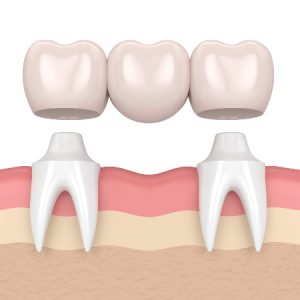 When you have a missing tooth, the whole balance of your mouth becomes disrupted. A missing front tooth can make taking bites and speaking more difficult. (And, of course, it’s more visible and embarrassing.) If it’s a back tooth that’s missing, well, at least it’s much less visible. However, a missing molar can make chewing your food extremely difficult (or downright impossible). If you have one or more missing teeth, a consultation with a dentist will help determine which replacement method is best for you. Options include dental implants, dentures, partial dentures, and dental bridges. In this instance, we’ll be taking a closer look at what’s involved with a dental bridge.
When you have a missing tooth, the whole balance of your mouth becomes disrupted. A missing front tooth can make taking bites and speaking more difficult. (And, of course, it’s more visible and embarrassing.) If it’s a back tooth that’s missing, well, at least it’s much less visible. However, a missing molar can make chewing your food extremely difficult (or downright impossible). If you have one or more missing teeth, a consultation with a dentist will help determine which replacement method is best for you. Options include dental implants, dentures, partial dentures, and dental bridges. In this instance, we’ll be taking a closer look at what’s involved with a dental bridge.
A lot goes into a dental bridge, and successful bridgework is genuinely an art form. As well as creating an aesthetic restoration to fix a missing tooth, it must be functional and durable enough to withstand biting and chewing.
What Is A Dental Bridge?
A dental bridge is one of the techniques we use to replace a missing tooth. We apply two crowns on the adjacent teeth (called the abutments) to hold the false tooth (called a pontic) securely in between. A dental bridge is sometimes known as a fixed partial denture because it replaces one or more teeth and is not removable.
If you have several missing teeth in the same area, we can also use dental implants to support a more extensive restoration.
Long-Term Outlook
Afterward, you will need to take a little more care to maintain your bridge, carefully brushing to ensure debris and build-up do not occur around the bridge. Additionally, since the bridge is a single unit, you will not be able to floss normally between the individual teeth. However, floss-threaders are available to assist in the process, helping you floss under the bridge itself. With proper care, there’s no reason your dental bridge cannot last as much as ten years or more.
While, of course, it would be best for everyone to keep all of their natural teeth, a dental bridge can serve as a great option when a missing tooth does occur. Please don’t hesitate to contact us for more information or to schedule a consultation!
